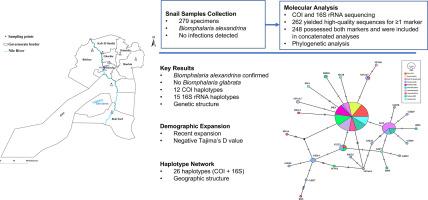Mitochondrial DNA analysis reveals genetic diversity and population structure of Biomphalaria alexandrina in Egypt: Implications for schistosomiasis control
IF 2.5
3区 医学
Q2 PARASITOLOGY
引用次数: 0
Abstract
Schistosomiasis, a debilitating parasitic disease, continues to be a significant global health challenge, with Biomphalaria alexandrina serving as the primary intermediate host for Schistosoma mansoni in Egypt. This study presents an extensive mitochondrial survey and phylogenetic analysis of B. alexandrina populations sampled from eight different Egyptian governorates, utilizing mitochondrial cytochrome oxidase I (COI) and 16S ribosomal RNA (16S rRNA) gene markers. Of 279 collected specimens, 262 yielded high-quality sequences for ≥1 marker, and 248 possessed both markers and were included in concatenated analyses. We identified substantial genetic diversity within the B. alexandrina populations, with 12 distinct COI haplotypes (accession numbers: PV926494-PV926505) and 15 distinct 16S rRNA haplotypes (accession numbers: PV874566-PV874580). Bayesian phylogenetic analyses confirmed that all collected Biomphalaria individuals belonged exclusively to the B. alexandrina species, providing no molecular evidence for the presence of B. glabrata in the surveyed areas, a finding crucial for epidemiological clarity. Furthermore, population genetic analyses indicated significant population structuring and varying levels of genetic differentiation among the B. alexandrina populations, suggesting the influence of geographical barriers and historical dispersal events, including recent demographic expansion. These findings offer crucial insights into the current genetic landscape and evolutionary dynamics of B. alexandrina in Egypt, which are vital for understanding the epidemiology of schistosomiasis and for developing more targeted, effective, and sustainable snail control strategies. The study underscores the importance of continuous molecular surveillance to monitor changes in snail populations and their potential impact on disease transmission dynamics, particularly in the context of ongoing environmental changes and control efforts.

线粒体DNA分析揭示了埃及亚历山大生物phalaria的遗传多样性和种群结构:对血吸虫病控制的影响。
血吸虫病是一种使人衰弱的寄生虫病,它仍然是一项重大的全球卫生挑战,埃及的亚历山大生物phalaria是曼氏血吸虫的主要中间宿主。本研究利用线粒体细胞色素氧化酶I (COI)和16S核糖体RNA (16S rRNA)基因标记,对来自埃及8个不同省份的亚历山大绿螺旋体种群进行了广泛的线粒体调查和系统发育分析。对262个钉螺个体进行了基因测序,结果表明,钉螺种群具有丰富的遗传多样性,鉴定出12种不同的COI单倍型(accession number: PV926494-PV926505)和15种不同的16S rRNA单倍型(accession number: PV874566-PV874580)。贝叶斯系统发育分析证实,所有收集到的Biomphalaria个体均属于alexandrina种,没有提供在调查地区存在glabrata的分子证据,这一发现对明确流行病学至关重要。此外,种群遗传分析表明,亚历山大白檀种群之间存在显著的种群结构和不同程度的遗传分化,表明地理障碍和历史扩散事件的影响,包括最近的人口扩张。这些发现为了解埃及亚历山大螺旋体的遗传景观和进化动态提供了重要的见解,这对于了解血吸虫病的流行病学以及制定更有针对性、更有效和可持续的蜗牛控制策略至关重要。该研究强调了持续分子监测的重要性,以监测蜗牛种群的变化及其对疾病传播动态的潜在影响,特别是在持续的环境变化和控制努力的背景下。
本文章由计算机程序翻译,如有差异,请以英文原文为准。
求助全文
约1分钟内获得全文
求助全文
来源期刊

Acta tropica
医学-寄生虫学
CiteScore
5.40
自引率
11.10%
发文量
383
审稿时长
37 days
期刊介绍:
Acta Tropica, is an international journal on infectious diseases that covers public health sciences and biomedical research with particular emphasis on topics relevant to human and animal health in the tropics and the subtropics.
 求助内容:
求助内容: 应助结果提醒方式:
应助结果提醒方式:


